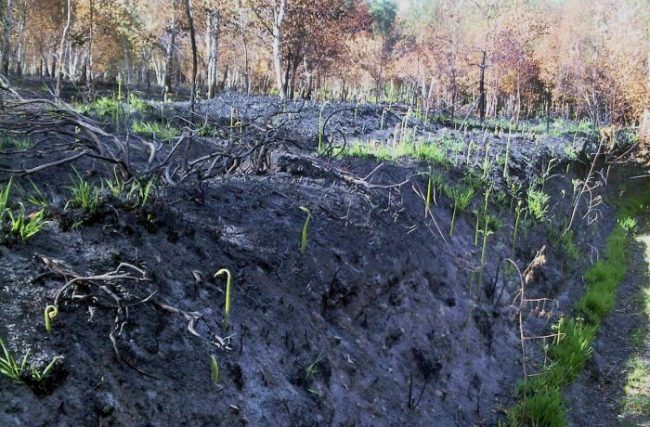Fire and forests.

There is evidence that trees lost to fires and drought are not returning to fire damaged areas. Fire has been ‘part and parcel’ of the dynamics of some forest ecosystems. The fires take out smaller trees, giving space and light to others. Fire (or the smoke associated with it) can even help the seeds of some species to disperse and/or germinate (eg. serotiny in certain Pines). Different chemicals from smoke such as karrikinolide and glyceronitrile are known to play key roles in smoke-stimulated germination of certain species, such as heather.
However, climate change is affecting forests (and woodlands) across the globe. Fires are becoming more frequent (associated with increasing drought) and trees are struggling to return / regenerate after intense or repeated fires. An analysis of a number of sites in the Rocky Mountains suggests that in some areas fire, moisture stress and increasing temperatures result in a loss of resilience so that forested areas are being replaced with shrubs, grassland and flowers.
"Fire refugia" are areas that somehow avoid significant or frequent damage; they burn less often and/or less intensely than the surrounding landscape. Such areas are important in the recovery of the ecosystem after a fire - allowing re-population of the area with a variety of species.

Woodland recovering from a fire
Consequently, studies have been directed towards understanding the physical and biological nature of such refugia. The work has focused on mature, conifer dominated forests in the States (The Klamath-Siskiyou region) and the fires that have occurred over a period of some 30 years. It was found that refugia were associated with physical features of the habitat such as rocky outcrops, depressions in the landscape. It was also noted that the density of the smoke that the fires generated was a factor in tree survival (perhaps dense smoke offered a degree of shade?).
 The area studied has a complex and diverse geology, with varied habitats that support considerable biodiversity. Fire has always been a key factor in the maintenance of the varied landscape but with the climate becoming hotter and drier, there is concern that an increasing frequency of fires will ‘eat away’ at the forest’s ability to regenerate - with the loss of refugia and incineration of seed banks in the soil.
The area studied has a complex and diverse geology, with varied habitats that support considerable biodiversity. Fire has always been a key factor in the maintenance of the varied landscape but with the climate becoming hotter and drier, there is concern that an increasing frequency of fires will ‘eat away’ at the forest’s ability to regenerate - with the loss of refugia and incineration of seed banks in the soil.
Severe fire can reset the path of succession - so that forest can be reduced to bare soil. Complex and established communities of fungi, microbes, plants and animals are lost, reduced down to bare soil. Intense heat will damage the structure of the soil, reducing its organic content and its complex community of microbes. In extreme cases, this can lead to the erosion of the soil.
Comments are closed for this post.
